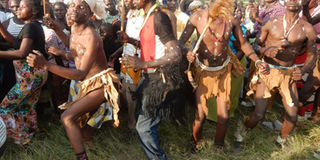Celebrating the wealth of ethnicity

Traditional dancers from Zeu Sub-county display their Agwara dance skills during the Alur community cultural gala in Arua Town recently. Below (R), the dancers blow the Agwara. Below (L), residents join the dancers. PHOTOS by FELIX WAROM OKELLO
What you need to know:
Alur. Little known by the youth, the richness of the culture in Nebbi and Zombo districts will leave you yearning to discover more
Culture is a web of flows, multiplying, converging and crossing. Some of the interconnecting whirls of culture are visible on the surface, others are hidden deep below.
Culture is everywhere in human life and society. West Nile region is not exceptional and has rich cultural practices.
However, these have been obscured by modernity thus are often unclear, especially to the youth who live in a generation where discos are more heard of than traditional dance ceremonies. Nonetheless, different communities over the past few years tried to revive their heritage through cultural galas such as the recent one held at Arua Hill.
It was organised by the Alur Community in Arua. Different cultural aspects that shape the community, from regalia, such as Oraki from Jonam County, dance and popular Agwara from Opano dancers in Zeu Sub-county, folk songs, which were displayed to set a vibrant pace for the day. Speaker after speaker re-echoed the importance of culture, with its unifying effect as the common denominator.
“We should use cultural diversity to ensure peace, harmony and unity among the different tribes in West Nile and denounce the cultural practices that promote divisionism. We are one but with different cultural norms,” said Dr Amos Nyathirombo, The Chairperson of ACA.
He added that traditional culture and modernity should be co-related to seek peace and development. However, the importance of keeping the torch burning through youth was emphasised as the only way to salvage culture.
According to Dr Edwin Wathum, the Alur Kingdom Prime Minister, there is need for parents to enlighten their children on these sacred customs.
“Let us educate our children so that we steer development of the region that has diverse culture which we must guard from fading away,” he said.
Cultural institutions too were challenged to use their programs to educate and inform the public on their roles in modelling good citizens.
The occasion was summed up by popular Oraki and Agwara dance.
For the Alur in Nebbi and Zombo, the Agwara instrument is blown by both men and women at social occasions.
The dancers follow the rhythm of the drums dancing linear and circular formations with characterised leg and waist movements while wearing ankle bells.
The Agwara has seven pitch levels. It is accompanied with about four drums (vul) in Padyere County and two drums in Okoro, in Zombo District.




